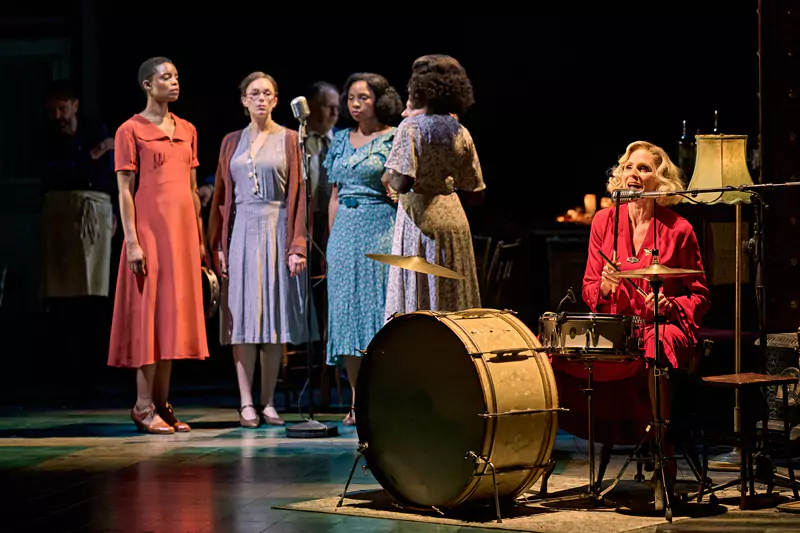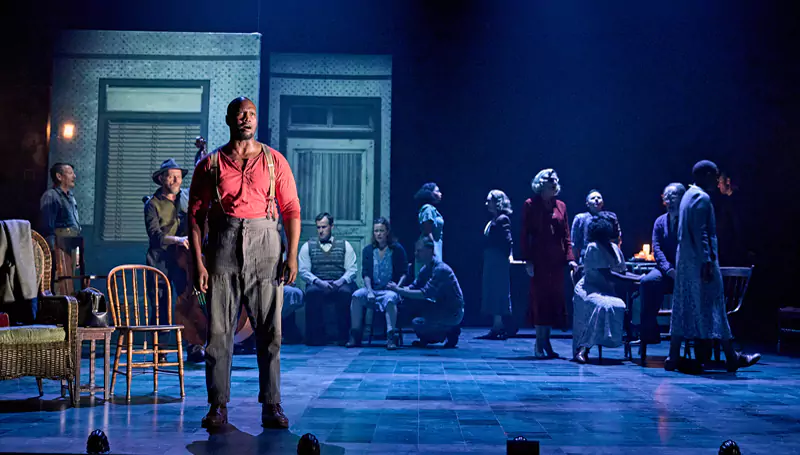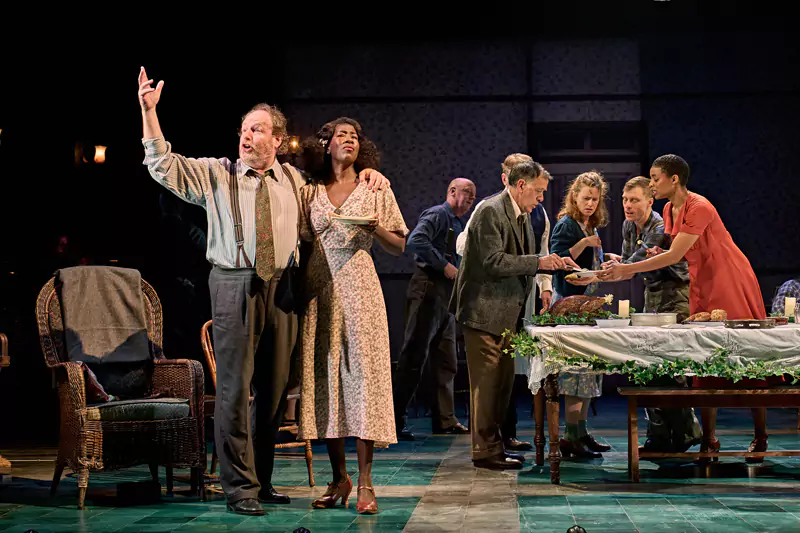“Girl from the North Country” at the Old Vic
Franco Milazzo on the South Bank
10 July 2025
Out with the new, in with the old: as Conor McPherson’s latest miserython The Brightening Air ends its run at the Old Vic, one of his best-known works takes its place. Since it first appeared here in 2017, it has been up and down the country and around the world. It may say “jukebox musical” on the label but don’t go expecting jazz hands. Instead, the opening scene features the Irish playwright’s signature brooding narration and a cast that look and move like the family dog has just died. Welcome to Girl from the North Country, where the hits of Bob Dylan have been steeped for an eternity in despair and desperation.

Photo credit: Manuel Harlan.
Set in 1934 Duluth, Minnesota (the birthplace of the Bobfather himself), the show takes place in a run-down guesthouse populated by an ensemble of characters whose dreams are either dead, dying, or having a long lie-in. The guesthouse owner, Nick Laine (played with world-weary charm and a side-order of existential dread by Colin Connor), is watching his finances crumble faster than the cliffside on which the town teeters. As his wife Elizabeth (who may or may not be losing her mind), Katie Brayben floats around in a semi-lucid state spouting sharp truths and sweary comebacks.
Also staying at this B&B of broken dreams are a falsely accused boxer (Sifiso Mazibuko), a shady Bible salesman (Eugene McCoy), a pregnant unmarried girl (Justina Kehinde), and a family with more secrets than the Epstein files. The local doctor (Chris McHallem) wanders in to hand out medication and wanders out to narrate the goings-on before and after the events we see. It has all the bleak ambience of the final scene of an Agatha Christie mystery, if everyone had depression and the murder weapon was economic despair.
Even without the luxury billing of Ciarán Hinds, Shirley Henderson, and Stanley Townsend from the 2017 run, this cast work hard for each other and for the audience, adeptly sheep-dipping us in this mercilessly morose drama. Many of these actor-musicians have appeared in past productions so there is no surprise to see such strong performances across the board, though “strong” here means “soul-crushingly believable”. Rae Smith’s set is beautifully faded, all peeling wallpaper and creaking floorboards, with the mustiness of an old suitcase that once held dreams but now just smells of mothballs and regrets. Complemented by sterling work from Mark Henderson (lighting) and Simon Baker (sound), this eerie world of almost a century ago is constructed with grim precision.
Photo credit: Manuel Harlan.
McPherson, never one to shy away from the poetic gloom of it all, takes Dylan’s back catalogue and surgically removes it from any context in which it made sense. Musical supervisor Simon Hale’s arrangements strip away the glamour, leaving the songs unexpectedly nude. “Like a Rolling Stone” is now sung as a dirge about unfulfilled potential. “Forever Young”? A lullaby to lost innocence. “I Want You”? A mournful plea screamed at the void by someone who has clearly not been wanted for decades. It’s less “jukebox musical”, more “jukebox taken out and dumped into a vat of cheap whisky and midnight tears”.
And yet somehow this musical works. Not in the usual “I danced and sang until security told me to sit back down” way. No, it works like an existential punch to the kidneys. The songs are reimagined as elegies, laments, and ghostly echoes of the characters’ inner lives. When a character sings, it’s not to entertain but to confess, like karaoke at a wake.
The band is onstage, dressed in Smith’s period costumes and looking like they’ve just finished an impromptu hoe-down in the Dust Bowl. A drum kit sits in one corner and is occasionally spanked by one of the cast. The instrumentation is sparse (piano, upright bass, fiddle, the occasional accordion) but robust and all the better for it. Like the best lounge cabaret, the arrangements and delivery overcome the original failings of the musician: Dylan’s songs are stripped of their sneering nasal drawl and given the haunting purity of old American folk ballads. Who knew “Idiot Wind” could sound like a love song? (Bob probably didn’t.)
Standout moments abound. When Elizabeth suddenly bursts into “Like a Rolling Stone”, it’s a glorious, unhinged howl against a world that’s left her behind. The boxer, Joe Scott, delivers “Hurricane” with a righteous fury that makes you want to rage, rage, and rage again against the injustice of it all. And when the cast joins in harmony for “You Ain’t Goin’ Nowhere”, it’s so wistfully beautiful that even the most cynical audience member finds themselves blinking away what they swear is not a tear, just a speck of overpriced theatre ice cream.
It’s a bold gamble to pair McPherson’s signature blend of Celtic gloom and ghostly narration with Dylan’s lyrical obliqueness. But somehow, this odd couple works. One wonders what The Brightening Air would have been like if it had had this kind of treatment. But be warned: this is not your standard feel-good night out. There are no glittering finales. No big dance numbers. The closest we get to razzle-dazzle is a tap dance performed during a moment of such emotional bleakness that Fred Astaire himself would probably put on a cardigan and weep quietly in the wings.
Being both writer and director is never an easy combination and often speaks more to hubris than a singular vision. That’s not the case here, though: the many story strands are lovingly braided together by the end into a satisfyingly downbeat finale. You leave the theatre not with hope in your heart but a need for a hug. In this era framed by crises abroad and at home, McPherson’s unashamed tales of anguish and hardships – be it from political, financial, or emotional causes – seem to be the flavour of the month. His 1997 classic The Weir is due to open in the West End in September. Girl from the North Country, though, is still his towering masterpiece and one for the ages.










